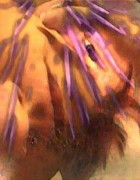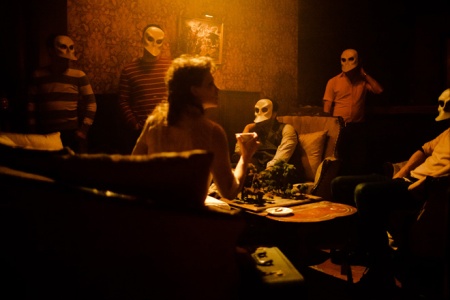Before, Beneath, and Beyond Participation
SECTION IV [Beneath the Artspeak]
PARTICIPATION IN PRACTICE
– Drawing from Stevenson, Grotowski, Chekhov, LeCoq, Stanislavski, Brook, Beckett, Cunningham, Debord, Etchells, Barney, Rokeby, Chouinard, Le Page, Viola, and other exemplifying cross / interdisciplinary practitioner’s interviews, reviews, reports, etc. Thus far I also anticipate cross-references to Heidegger, Douglas, Deleuze & Guattari, Dewey, Zarrelli, France, Taussig, Massumi, Agamben, Zizek, Lehmann, Kristeva. This section will inter-relate Artaudian, Brechtian, and Fluxus prescriptions to exemplifying, related but divergent practices, so as to provide comparative opportunities. Includes review of contemporary conundrums and challenges.
– Introduction: As there is no such aim to produce a non-participatory performance engagement; let’s speak of innovations, explorations, and experiments instead. My approach herein will reflect my own vantage point as an artist whom had, previously, contributed to a variety of cross-disciplinary creation processes from within the performing arts milieu. Review implications of confusions in prior section, that I’ve encountered more often from within plastic arts milieus, and note the performing arts is no less frozen in time. Touch on theatrical influences throughout disciplines and absorption of visual arts conceptions in the performing arts. Difficult theory, traditionalism, and confusions also exist, but more often relates to the revisiting of scripts and employment of new technologies. There nonetheless continues to be a diversity of contemporary practices that extend to site-specific works, public interventions, non-artist co-authoring, street theatre and immersive works, animated objects and new media, networked and virtual reality performing arts projects.
– Address Fourth Wall lexicography versus energetic, empathetic, and interpretative engagement in the Live Arts. Note that stagings need not occur upon a physical stage and are moreso reliant upon methodologies than spatial arrangements (will provide examples). Present quandaries surrounding alienation techniques in a new media and informational age, the predominance of signification and personalization in societal context, and diversity of episodic frameworks (will provide examples). In contrast, review experiences of alienation and forms of cruelty as they occur in regards to performance practices, and live engagements. Acknowledge the cinematic and new media understanding of fourth wall breaches, inter-relate this to performance compositions and approaches, and the suspension of disbelief. Introduce relevance to temporal experience and present comparative toward-belief engagement examples. Present my (unsolved) personal inquiries into ontological characters of engagement, as it relates to performance-premised works generally, and the conception of a Fourth Wall. Explain relevancy of these issues to a variety of contemporary compositions.
– Address the reported functions of absorption and disruption in practice. Summarize the relevancy to cinema and new media, as compared to embodied presences, and note the consistent reference to immaterial entanglement between a work and an audience. In the case of disruption (relates to Alienation Effect, ‘shock’, ‘trembling’ references) the aim has been and continues to be to expose, challenge, or undermine the predominate habit or conventions. As opposed to prescribing to or adhering to common expectations. Elements of surprise and unexpected circumstances are intended to open up perceptual opportunities wherein individuals might understand themselves and/or others and/or a circumstance differently. This remains a challenge, to practitioners across disciplines, and has long been at the crux of any calls for renewal in the arts (of relevance to all of the principal artists that will be reviewed herein).
– Address the predominance of spectacle and in context with egalitarian aspirations. Discuss a volatile or menacing cruelty, the desire for immersion, and the issue of embodiment in a body without organs. Review relationship between cruelty, abjection, and transgression. Note the risks in forgetting the body while pursuing virtuality, whether concretely or ethereally, and present potential bio-ethical issues (includes reference to psychology, ‘the very nervous system’, and confrontation scenarios). While subjective experience includes disembodied habits of perception, and societal norms ignore our organic requirements, still we unquestionably exist as bodies. Speak to the benefits of devising works through processes that allocate primacy of performance over text, or presentational system attributes, and explain how embodied practices are relevant to participant’s (dimensional) experiences. Relate this to embodiment transgressions and the evocation of horror, anxieties, and visceral sympathy (will provide examples). Reference examples of transformational immersion and / or inadvisable transgressive works.
– Address ‘hand of the artist’ versus ‘becoming the artist’. Co-creation, authoring, and instantiation. As previously noted, perceptions of influencing participant experiences may shift, but are not absolved, in contemporary art-making processes. Anti-expert sentiments sometimes go so far as to devalue supportive measures and an imparting from experience: Shamans, alchemists, and guides are specialists too. Review artists references to Being and Becoming. Performing artists harbour a wealth of under-investigated insights upon ephemeral journeys and states of alterity. This relates to the performing of characters and personae, as experiences that are dependent upon inter-subjective instantiations, and as individuals drawing upon on our life experiences (psychical / emotional / physical memory and associations). Performances that do not succeed in this instantiation are usually interpreted as dry or disenchanted stagings (relates to speach and behavative acts). Note personal experiences, explain my intrigue with the inquiry, and reference exemplifying (practitioner’s) reportage.
– Address the relevance of place-time / when-where situations, and storytelling, to ‘the merging of art and life’ (the ‘theatre’s double’). Refer to ‘the third space’ and openings in context with technics, where any form of participation takes place, whether self-consciously or otherwise. As attendees to a live performance, the performers frequently stand-in (metonymy) for others in multiple ways, whether it’s ourselves or someone we’ve known or someone we’d never imagine meeting. The creation of a world within a world does not usually aim to forget one for the sake of another either. Instead, the exceptional environment (as compared with those we inhabit daily) and the crafting of narratives serve to transpose, mirror, and/or contradict participant’s awarenesses. Artists across disciplines generally hope to learn they have succeeded in these same aims. Such feedback is certainly prized above compliments to the craftsmanship or congratulations for the work’s entertainment value. Narrative building elements (sub-text, symbolism, metaphor, allegory, etc) can provide for an inter-personalization that meets with, informs and stimulates, or perhaps even transforms subjective experience. Note personal experiences, explain my intrigue with the inquiry, and reference exemplifying (practitioner’s) reportage.
– Address plurality in creation processes, and potential misunderstandings, in relation to disciplinary needs. Discuss relationship between processes, and eventual participant involvements, and as it pertains to experiential dimensionality. Review the diversity of approaches and intentions surrounding subjective as compared to inter-subjective experiences. Note references to illusion / magic and allusion / instantiations, across disciplines, and in especial relation to uses of technology. Point to quandaries in expectations that participants meet with, arising conundrums concerning novelty, and introduce potential solutions. Review theoretical stances upon objectification and subjectification, as compared to practitioner and ethnographic reports, and note where emphasis is upon structural analysis over receptions / reflections / feedbacks. All of which has relationship to dialectic treatment of the live performer as an artifact, the presentational format as the conceptual object, and visiting participants as test subjects. Advocate cross-disciplinary collaboration as a method of addressing associated creation research requirements and challenges. Reference documented examples, commentary, and/or proposals that attempt solutions or describe constructive supports for negotiating with problematics.
– Concluding remarks. Note that the performing arts present us with timely exemplifications of immaterial involvement, ephemeral transformations, insights upon embodied journeying, interpersonal supports for improvisation, process-centric co-authoring, pragmatic working models, and the logistics of hosting communal events. Especially relevant – philosophically, sociologically, politically, economically, and creatively – is the generally accepted principals of collaboration. A value for which has been explicitly deprecated in the predominating North American culture. If we are compelled to honour the spirit of these practitioner’s aims, and to learn from our predecessors, we shall then also benefit from a reflective emphasis upon the general ethos that is championed. That which more accurately engenders the meaningful impetus beneath creative prescriptions, the calls for new movements, and the evolving artspeak.
This above is a work in progress. Related Posts:
Section I [Introduction]
Section II [Before Participation]
Section III [The Before in The After]
A List of Related Articles and Books.


Pingback: A Spectacular Narrative | scrapaduq
Pingback: A Pure Theatre | scrapaduq
Pingback: Badac’s Cruelty | scrapaduq